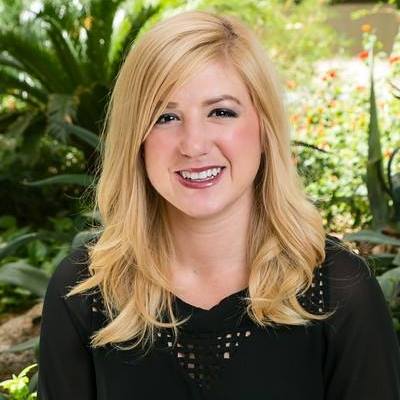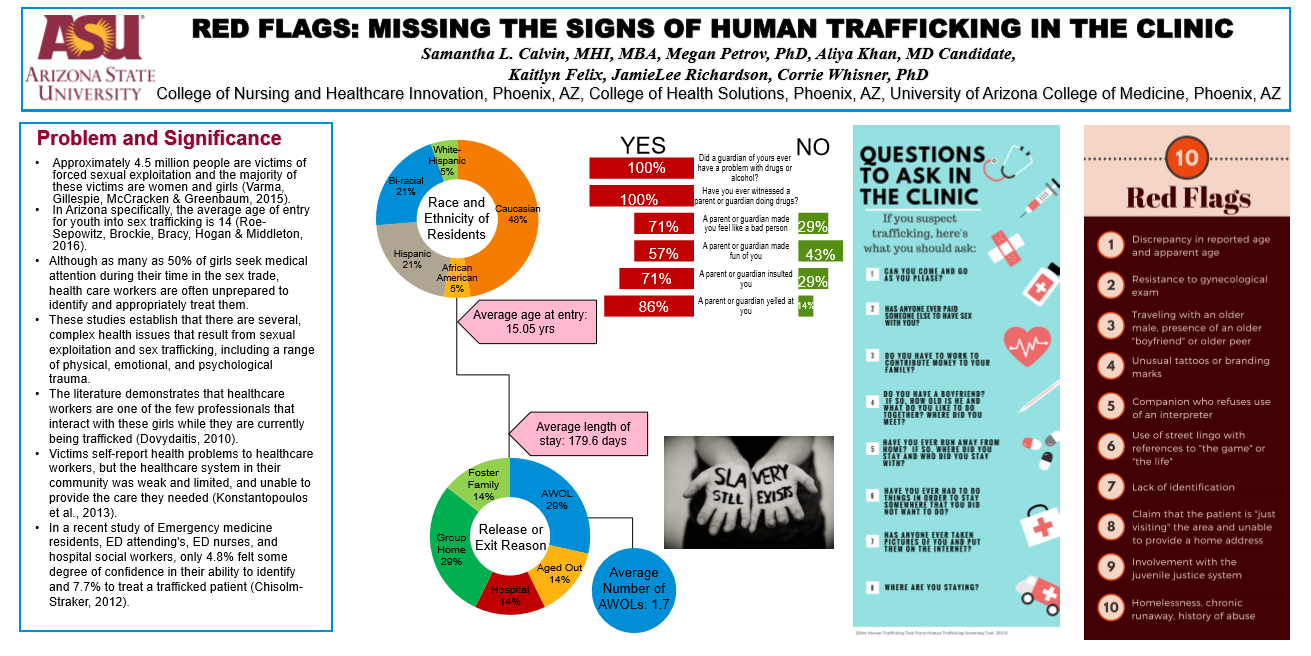A patient enters an examination room. She is young —14, maybe 15. She is walking gingerly; wearing sneakers, baggy jeans and a sweatshirt — in 104-degree weather. A few steps behind her is another young woman, a little older, early to mid-20s maybe. She hands over a clipboard with the patient’s medical information and introduces herself to the attending nurse practitioner as the patient’s aunt.
A quick scan shows the document is missing an address and contact information. The aunt quickly explains that they are both staying with some friends in the area until they find a new apartment. The patient remains silent; eyes cast downward; she looks nervous. She speaks softly, offering just a few words about a sore throat and discomfort in her lower back when the nurse practitioner asks what brings her in today.
Standing in a corner of the room just a few feet away, the aunt’s anxious glances alternate between the back of the patient’s head and the examiner's questioning lips. Bruises dot the patient’s arm when she rolls up her sleeve to allow a blood pressure cuff to be wrapped around her upper arm. The nurse practitioner casually asks how she got the bruises on her arm. A tense silence fills the room. The aunt shifts her weight before reminding the patient of her recent mishap with the boxes they were moving.
The patient’s eyes meets the nurse practitioner’s eyes.
What the nurse practitioner decides to do next could be life-altering for all of the actors in this scenario. And that is just what Samantha Calvin hopes will happen after students take her new class through Arizona State University’s College of Nursing and Health Innovation this fall.
It’s called HCR 394: Fundamentals of Human Trafficking. One of the first of its kindCalvin says ASU is breaking new ground by offering a Human Trafficking class in its nursing school as few universities have this option in their nursing schools. HCR 394 is open to all majors. at ASU, Calvin says this class will educate present and future health-care industry professionals, like the nurse practitioner in the above dramatization, on how to identify and speak up for those who are unable to do so for themselves.
“Seventy to 80 percent of the girls who are being trafficked see a health-care professional at some point but end up going right back to the streets or the pimps because they are not identified as victims,” Calvin said. “There is room to stop the trafficking cycle during that visit, and that’s why a class like this is a good fit for a health-based college like the College of Nursing and Health Innovation.”
Calvin says Fundamentals of Human Trafficking will tackle the role of the health-care professionals by educating students on spotting signs of exploitation during encounters with patients; what questions to ask and how to ask them if it appears that a victim is unable to speak for themselves. Localizing the subject of human traffickingIn 2016 there were 457 calls and 151 reported cases to the National Human Trafficking Hotline in Arizona: http://endsextrafficking.az.gov/, students will also have the opportunity to work with community-based nonprofits and assist in creating, solving or evaluating a problem or a program that the organization is doing around the topic.
With vocal support from the McCain Institute for International Leadership at ASU, Calvin’s class has been almost two years in the making — the result of the passion she has had for the subject since becoming a mentor for young survivors recovering from the trafficking trade.
ASU Now sat down with CalvinCalvin is a graduate student in the College of Nursing and Health Innovation, of which she is also a full-time faculty member. to discuss human trafficking, its impact on local communities and why the time is right for her new class at ASU.
Question: There appears to be a growing interest and effort to take action against human trafficking more so in recent years than others. What do you attribute to the increase in awareness on the issue?
Answer: Media and pop culture have become strong drivers in the rise of awareness about human trafficking. When I tell people I do research in this area, many will bring up a documentary on human trafficking that they might have seen on Netflix, and in recent years we have seen more billboards going up in major cities that warn people not to buy sex from teenagers. We are also beginning to see anti-human-trafficking campaigns around sporting events such as the Super Bowl and the Final Four here in Phoenix.
Q: How is human trafficking defined in the context of your class?
A: Everyone has a different construct of it — and then the lines of trafficking and prostitution can get very blurry. From a legal standpoint, anyone under the age of 18 who is trading sex for anything, whether it is clothing or shelter or money, they are being trafficked. It gets more difficult to define when that person becomes a legal adult because that line of when are you choosing to do something and when you are not becomes a little more unclear. Many pimps will use techniques — different forms of brainwashing and manipulation — that influence the victim’s belief that they are choosing to engage in this lifestyle.
Q: One of the unique components of HCR 394: Fundamentals of Human Trafficking is students getting the opportunity to create their own research projects. What might a research project in your class look like?
A: Students will be assisting local organizations that address human trafficking. They might be collecting and analyzing data and research for dedicated nonprofits that are lacking in funding and resources. We hope to bring these organizations together and discuss the challenges they face and ways they might be able to help each other toward the common goal of stemming human trafficking. We also plan to have regular dialogues with people who have been involved in human trafficking — people in social work and law enforcement, former johns, former traffickers and people who have been trafficked — to learn how the problem is viewed from different perspectives.
Q: What are some of the assumptions or misconceptions people have about human trafficking?
A: The first question I usually get when I say I do human trafficking research is “What country do you do it in,” assuming it could not be happening locally. Then, when I reveal that my research is based here in Arizona, many will assume it is related to the U.S.-Mexico border, which is also not the case because most of the girls I work with are U.S. citizens. Also, while a lot of the focus is often on young women, our class will address the fact that there are a great number of young men who fall victim to human trafficking, particularly within the LGBTQ community. The issue itself is so complex that even people who are medical professionals may be not be aware that human trafficking is a problem that they should be looking for.
Q: What are some of the identifiers health practitioners are missing, or not acting on, when they come in contact with trafficking victims?
A: Trafficking victims might engage with health practitioners for a number of reasons. Often it’s something that prevents them from performing their “duties.” But traffickers might also send victims into health-care facilities to get checked for sexually transmitted diseases. In many of those cases, the trafficker, or a representative for the trafficker, might pose as a relative or a boyfriend, fill out medical paperwork for that person and remain present or close by during the examination. Health-care personnel should flag observations such as lack of identification or the patient’s inability to answer basic questions like a description of where they live, or the color of their room.
A patient who has been subjected to trafficking might have bruises and markings. In some cases, traffickers will brand their girls — so there are certain tattoos or numberings health professionals should look out for. If they are not sure what to do, health-care professionals should call the national hotlineCall the National Human Trafficking Hotline toll-free at 1-888-373-7888. dedicated to human trafficking if they suspect a patient is being trafficked.
Q: By the completion of this course, what should students have in their toolbox to help them address the subject of human trafficking?
A: They should understand how significant human trafficking is and what it looks like in Arizona, nationally and globally. I think they will also be able to understand the intersection of policy and cultural elements related to human trafficking. It could be as simple as rethinking the issue and being more available to ask someone if they need help — even if that person is not being trafficked. I think the person who completes this course will be more equipped to volunteer in their community around these issues and inform people who are unaware that trafficking is something that is happening locally, down the street. I think they will also know more about the theories about human trafficking, the psychology behind wanting to buy another human being.
If we want to put an end to human trafficking in any way, we need classes like this to help start the conversation that will help these students go out into the world and make a difference in their chosen profession. Because I think this issue is so complex and so interdisciplinary, there is not one profession or one space or corner of the Earth that it does not impact in some way.
More Law, journalism and politics
Can elections results be counted quickly yet reliably?
Election results that are released as quickly as the public demands but are reliable enough to earn wide acceptance may not always be possible.At least that's what a bipartisan panel of elections…
Spring break trip to Hawaiʻi provides insight into Indigenous law
A group of Arizona State University law students spent a week in Hawaiʻi for spring break. And while they did take in some of the sites, sounds and tastes of the tropical destination, the trip…

LA journalists and officials gather to connect and salute fire coverage
Recognition of Los Angeles-area media coverage of the region’s January wildfires was the primary message as hundreds gathered at ASU California Center Broadway for an annual convening of journalists…




